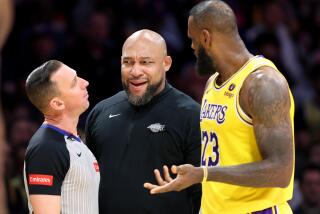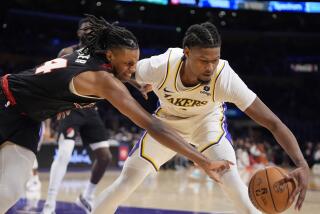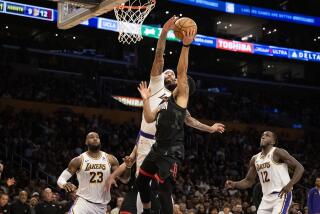Kobe Bryant’s rest should pay long-term dividends
As Kobe Bryant sat on the bench wearing a suit and a walking boot, the Lakers received a visual reminder of what they don’t have.
Andrew Bynum felt it as double teams swarmed on him as the primary option. Pau Gasol sensed it as he picked up a larger offensive load. Ramon Sessions experienced it as he became a pick-and-roll point guard looking to score instead of worrying about how to set up the Lakers’ star.
With the 1-1 mark since the Bryant’s absence because of an injured left shin, the Lakers have shown a mixed bag in absorbing his loss. But in the long term, none of these developments really matter. Whether he returns Wednesday against San Antonio or remains sidelined, the only thing that matters points to Bryant’s health and the amount of rest he enjoys before his return.
The Lakers (36-22) may have a 1 1/2-game lead over the Clippers (34-23) for the third seed in the Western Conference and trail San Antonio (40-15) by 5 1/2 games for the second spot. But battling for playoff seeding will hardly bode a huge factor on how the Lakers fare in the postseason. Bryant’s health and energy level remain of higher importance, which is why it’s good the Lakers have exercised caution with his injury.
“It’s good for him to take some time off and get his body right and get this injury right, especially at this point in the season,” Lakers Coach Mike Brown told reporters. “I’d rather he be fresh going into the playoffs and us be fourth or fifth [in the conference] than him hurting or dinged up going into the playoffs and we’re third.”
Brown has long professed that, putting little importance on playoff seedings and acknowledging the need to limit Bryant’s minutes. But very few times has he actually done that, unless you count Bryant’s mysterious benching four weeks ago against Memphis that still lacks a valid explanation. Otherwise, Brown has hesitated to lower the workload for Bryant, who’s averaging 38.9 minutes a game, fourth in the NBA.
He argues he wants to tighten up the rotations so the team gets used to it before the playoffs. Brown expressed insecurity in how rookie Andrew Goudelock would remain an effective shooter when he often presents a height disadvantage on defense. He’s seen the Lakers routinely struggle managing double-digit leads against both playoff-caliber teams and ones with sub-par records.
As the Lakers illustrated in the past two games, however, their flaws go beyond needing Bryant’s assistance. They routinely allowed Phoenix and New Orleans to burn them in transition and from three-point range (conceding a combined 23-of-44 mark). They inconsistently displayed the effort level needed to put games away early. The Lakers’ offense remained collectively fast and effective.
Bryant might have helped bail the Lakers out in an ugly game against Phoenix. He could have made their effort against New Orleans a tad more respectable. But three weeks from now, the Lakers won’t remember these performances or attribute them much as making or breaking their development. Instead, they’ll see if Bryant’s healthy and energetic enough to lead the Lakers into a deep postseason run once again.
RELATED:
Five things to take from Lakers’ 93-91 win over HornetsLamar Odom couldn’t handle adversity as well as he once did
Kareem Abdul-Jabbar unsure what to make of Andrew Bynum’s behavior
More to Read
All things Lakers, all the time.
Get all the Lakers news you need in Dan Woike's weekly newsletter.
You may occasionally receive promotional content from the Los Angeles Times.






